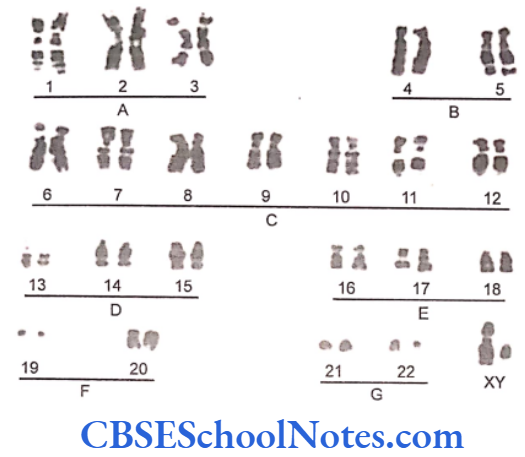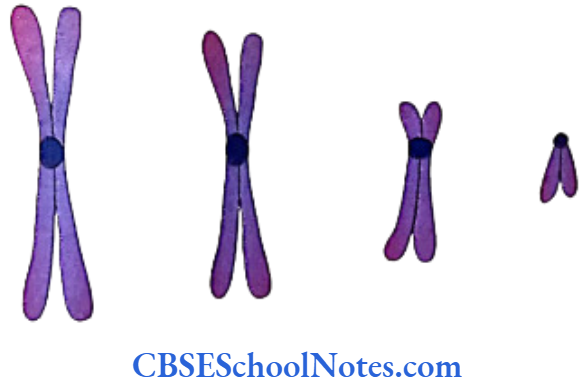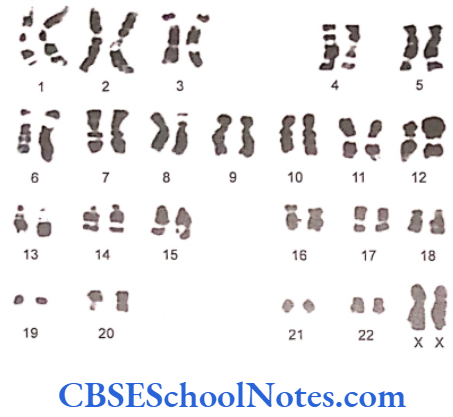Chromosomes And Their Classification
It was the beginning of the 20th century that the importance of Mendel’s findings was beginning to get appreciated. This was due to simultaneous understanding of several aspects of the cell division and the structure of the chromosome.
The first account of mitosis was accounted by A Schneider in 1873 followed by W Fleming in 1879 who described the migration of individual chromosomes into the daughter cells after the detachment of the sister chromatids.
Subsequently Brenden showed haploid (half) number of chromosomes in the gametes and restoration of the diploid number of chromosomes in the somatic cells after fertilization.
It was 1902 when Walter S Sutton and Theodore Boueri came up with the ‘chromosome theory of heredity’ that claimed that Mendel’s pair of ‘hereditary factors’, were in fact, physically located on the chromosomes.
According to Mendel each trait was represented by a pair of factors. The presence or the absence of one or both the factors determined the expression of that particular trait in an individual.
The emerging concepts of gametogenesis and fertilization further explained Mendel’s observations, calculations and foresight.
Read and Learn More Genetics in Dentistry Notes
Introduction To Human Chromosomes
The human chromosomes are nuclear structures. They look like a net that is spread across the nucleus in a nondividing cell (interphase). The strands of the net are called chromatin and are chiefly made up of Deoxyribonucleic acid (DNA) and histone proteins; stained dark with basic dyes.
Certain areas in the net look thick, coiled and condensed and are called heterochromatin whereas certain other areas resemble thin and lightly stained threads termed the euchromatin.
The euchromatin is active during the functioning of the cell. The chromosomes get fully coiled and look like separate and individual thick rod like entities only during cell division.
The chromatin net structure is restored once the cell has completed its mitotic or meiotic phases of cell division.
The Number of Human Chromosomes
- The number of chromosomes is always specific and constant for each species.
- In each of human somatic cell there are 46 chromosomes referred to as the diploid set and designated as 2n.
- The 46 chromosomes can be grouped into 23 pairs of chromosome; each pair different from the other. The constituent partners in a group are very similar to each other.
- During the process of formation of sperm or ovum (gametogenesis), the number of chromosomes is reduced to half, i.e. to 23 or to haploid (n) state with one chromosome from each pair of the diploid set migrating to the gametes.
- With fertilization the haploid sets (n/23) of the sperm and the ova fuse to restore the diploid set (2n/46) in the first cell of the embryo.
- Chromosomal Classification into Autosomes and Sex Chromosomes
- The complement of 46 chromosomes in each human cell is classified into 44 autosomes (22 pairs) and 2 sex chromosomes (1 pair).
- One member of each pair of autosomes and sex chromosome is contributed by either the father (paternal) or the mother (maternal).
- The sex chromosomes are of two different types; the X and Y chromosomes.
- The chromosomal constitution of the females of the human race is 44 autosomes and two X chromosomes (44 + XX), forming a homomorphic pair of sex chromosomes.
- The chromosomal organization in human males is 44 autosomes and a pair of dissimilar sex chromosome, (44 + XY), i.e. one X and one Y chromosome, forming a heteromorphic pair of sex chromosomes.
- The Y chromosome is always contributed by the male parent via its Y chromosome-containing-gamete.
Chromosomal Size and Shape
The Chromosomes remain extended and uncoiled in the interphase stage of cell cycle with the length of the chromatin, if measured, extending a few meters.
The chromosomes coil and condense maximally during the metaphase stage of cell division when the average size of the chromosomes is about 5μm. It is during the cell division that we can, in fact, visualize individual chromosomes.
Chromosomes look like an entangled mesh of chromatin thread when in the interphase. Prior to the oneset of cell division and progressive thickening of individual chromosome, each chromosome undergoes duplication of its DNA content and appears like two closely placed free strands attached together roughly near their waists.
This event is called the phase of DNA replication. Subsequently during the later stages of cell division, as the chromosomes get condensed further; each of them looking like a thick rod (in metaphase) or like the letters J or V (in anaphase).
Chromosomal Structure
Each metaphase chromosome comprises of two identical components (after DNA replication). These two symmetrical halves are called sister chromatids and they are attached together at a constricted region that stains lightly and is called the centromere.
The centromere defines the primary constriction of the chromosome and divides the chromosome into a short arm (p) and a long arm(q). Centromeres play a pivotal role during the movement of chromosomes during cell division.

Certain chromosomes usually carry an additional secondary constriction in one or both the chromatids. These constrictions are linked to the formation of the nucleolus and hence referred to as the nucleolar organizing region.
The secondary constriction may lie at the distal end of a chromatid giving rise to a small fragment of chromosome at the extreme end of the chromosome called the satellite.
The centromere (primary constriction) is situated anywhere along the length of the chromosome. The level of the constriction and consequently the lengths of the p and q arms are different for different chromosomes but specific for a particular chromosome.
The location of the centromere, the length of the chromosome and the existence of satellites are taken as parameters to classify as well as to identify chromosomes.
Classification Of Chromosomes And Analysis
Classifications are used to identify chromosomes.
- Standard (Denver) classification:
- Chromosomes are classified into seven groups in an arrangement in descending order of their lengths. Groups are designated alphabetically from groups A to G. The longer female sex Chromosome X is included in the group C and the smaller male sex chromosome Y is included in group G.

- Classification based on the position of the centromere:
- Metacentric: Centromere located near the middle of the chromosome; the length of p = q.
- Submetacentric: Centromere located slightly away from the middle; the length of p < q.
- Acrocentric: Centromere located very near to the end; the length of p << q.
- Telocentric: Centromere located at one end of the chromosome; effectively having only a single arm.

- The Paris nomenclature: This classification entails banding techniques (special staining) and therefore is more accurate in identification of chromosomes. The arms of the chromosomes are divided into short segments and designated numbers 1, 2 and 3 beginning from the centromere and proceeding distally. Each of these small segments or regions is subdivided into Z banded regions. Thus not only a particular chromosome and a segment in its arm can be accurately identified in this classification; small structural anomalies can also be detected within small regions in the segments.
Chromosomal Analysis
Chromosomal analysis is an accurate tool to investigate several clinical conditions to arrive at a precise diagnosis. It may be indicated in cases of congenital malformation, mental retardation, repeated abortion, sex determination, prenatal diagnosis and other analytical purposes.
The chromosomal make-up of an individual is called as his or her karyotype. Karyotype is essentially a photomicrograph of an individual’s chromosomes arranged according to the standard classification. Diagrammatic representation of karyotype is called as ideogram. A karyotype is done to:
- Identify and number the chromosomes
- Detect numerical and structural anomalies of chromosomes.
Technique of Karyotping (Chromosomal Preparation)
The procedure to obtain a karyotype of an individual is called Karyotyping. The metaphase chromosomes from somatic cell are prepared and photographed. Photographs of individual chromosomes are cut and arranged as per the Standard Classification.
Rapidly dividing cells are used to yield the chromosomes. The cells are usually obtained from sources like peripheral blood lymphocytes (most commonly used), skin fibroblasts, bone marrow cells, chorionic villi and amniotic fluid cells. The sequential steps followed and described below.
About 5 ml of venous blood is collected in a heparinized vial under sterile conditions and then the Lymphocytes are separated from the red cell population with the help if a centrifuge.
A culture via is prepared that contains culture media and fetal calf serum for nourishment of the lymphocytes. Phytohemagglutinin in the vial stimulates cell division. Antibiotics are added to the medium to prevent infection.

The white cell suspension is then put in the culture vial. The vial is incubated for three days at 37°C.
Colchicin stops the formation of mitotic spindles and arrests cell division in metaphase. The chromosomes are maximally condensed and easily visible at this stage.
The dividing lymphocytes are separated off with a centrifuge 2 hours after the colchicin is added.
The cells are subsequently treated with hypotonic saline. This causes the cells to swell and become turgid.
The cells are then fixed by adding a mixture of glacial acetic acid and methanol.
When the cells get suspended in the fixative, they are dropped on chilled slides from a height. This causes the cell wall to disintegrate thereby allowing the chromosomes to spread in a limited area of cell rupture. This is called the metaphase spread.
These slides are stained and microphotographed. The Karyotype of an individual is obtained after the images of chromosomes are cut from the photograph and arranged. Karyotypes of male and female sexes.
Banding of Chromosomes
Banding techniques allow precise analysis of chromosomes. Bands are obtained with the help of several staining methods.


G-banding
Unique pattern of light and dark bands are obtained on the chromosomes after treating the slides with trypsin that denatures the chromosome proteins and then staining the cells with Giemsa solution.
Q-banding
The method involves staining of chromosomes with quinacrine mustard. The pattern of banding is similar to the G-banding but the slides can only be visualized under ultraviolet fluorescent microscope.
R-banding
R-bandings are the reverse banding as seen in G-banding. The slides are preheated before staining with the Giemsa solution.
C-banding
Both the primary as well as the secondary constrictions are stained with this method.
Fluorescent in situ Hybridization (FISH)
This technique is based on the principle of DNA hybridization. A radiolabelled single stranded DNA probe is manufactured having a known and desired sequence of nucleotides. This probe gets annealed to the complementary target sequence on the interphase or metaphase chromosomes. These probes can be localized on a nitrocellulose filter by autoradiography. The technique is now widely used as it is accurate and rapid.
Various types of FISH available are:
Centromeric Probe
These probes are helpful for identification of chromosomes. Each chromosome has highly repetitive and specific DNA sequences in and around the centromere. The probes are designed to identify a particular chromosome accurately.
Chromosome Specific Unique Probe
These probes are designed to anneal onto very precise segments of the chromosome that bears unique sequences of DNA. They are useful even to detect sub-microscopic deletions or duplication.
Whole Chromosome Paint Probe
Entire chromosomes are visualized with this technique.
Multicolor Spectral Karyotyping
This technique allows observing all the chromosomes simultaneously. A multicolor spread is obtained after all the chromosomes are painted or fluoresced to get a multicolor karyotype. Special Karyotyping (SKY) detects chromosomal deletions and translocations.
Sex Chromatin
Interphase nuclei in the female exhibits a dark stained mass of heterochromatin just beneath the nuclear membrane. This mass of chromatin material is called the sex chromatin or Barr body. Sex chromatin is observed only in females and is absent in males. It is thus a tool for determination of sex in humans.
The identification of Barr body can be done rapidly after isolating epithelial cells from the skin, vagina and oral cavity or from blood cells. Typically, the buccal mucosa is scraped and put on a slide and evenly spread. The cells are then fixed in alcohol. The slides are observed under high magnification after staining with any basic dye. Chromatin positive cells usually denote a female sex

Human female polymorphonuclear white cells also show a small drumstick like structure at one end of the nucleus. This drumstick body is absent in males. The Barr body technique is not a very suitable method for determination of sex. Karyotyping is a more acceptable and accurate method for the purpose.
Barr Body and the Drumstick are Features of the Female Nuclei
The distinct relation between sex chromatin and sex chromosomes was worked out by Ohano, Kaplan and Kinosita in 1959. They observed that the sex chromatin was derived from one of the two X chromosomes in females. In females one of the X chromosomes became the condensed and inactive heterochromatin (Barr body) whereas turned into euchromatin, active in cellular metabolism.

Lyon’s Hypothesis
The process of inactivation of one X chromosome is called Lyonization after Mary F Lyon. In 1962 she demonstrated that during the early stages of embryogenesis at about 15th or 16th day of development, one of the X chromosomes convert into a coiled and inactive heterochromatin structure; the Barr body.
Features of Lyonization
- One of the two X chromosomes becomes inactive.
- The inactivation occurs at about 5000 cell stage in early embryonic life.
- The X chromosome in a female cell is randomly selected for inactivation. Thus is some cells the maternally derived X chromosomes are inactivated whereas in the rest the inactivated X chromosomes are of paternal origin.
- Therefore the cell populations in a female represents a mosaic pattern with respect to having a cluster of cells with active paternally derived X chromosomal genes and also a set of active X chromosomal genes of maternal origin, in the same individual.
- During cell division the Barr body uncoils and participates in the division and shows late replication.
- After cell division the same X chromosome gets inactivated again. This pattern continues in all subsequent cell divisions.
- Barr bodies may number more that one but the number of Barr bodies is always one less than the total number of X chromosomes in the cell.
Thus Barr bodies in the following situations are as follows:
Normal male(XY) exhibit no Barr body, normal female(XX) – One Barr body, Turner syndrome (X0) no Barr body, klinefelter syndrome (XXY) – One Barr body and triple X syndrome (XXX) – two Barr bodies.
Thus at any time point a somatic cell contains only a single active X chromosome and the other X chromosome (s), if present, shows up ad Barr body/ bodies.
The Importance of X Inactivation
At its onset embryogenesis in the females requires active participation of both the X chromosomes. Thereafter one of the X chromosomes is randomly inactivated in subsequent course of development. The presence of only a single active X chromosome in either a male or a female cell is sufficient to maintain the protein levels expressed by the genes on the X chromosome.
The presence of an extra active X chromosome causes the dose of the gene products to be double and are eventually deleterious or fatal. Nature has thus evolved a mechanism of inactivation of an X-chromosome for the regulation of dose of its genes. This mechanism is called dosage compensation.
The Y chromosomes never from Barr bodies though at times they may be more than one in number in certain abnormal situations. This is because the Y chromosome has very few genes and has very negligible influence on the phenotype. Hence the Y chromosomes are not subjected to dosage compensation.
Classification Of Human Chromosomes Summary
- The human chromosomes are 46 in number comprising 22 pairs of autosomes and a pair of female (XX) and male (XY) sex chromosomes.
- Chromosomes are visualized during cell division. Metaphase chromosomes are thick rod like. The centromere forms the primary constriction. Chromosomes are classified according to the location of the centromere into metacentric, submetacentric, acrocentric and telocentric.
- Karyotype denotes the chromosomal make-up of an individual.
- Chromosomal spreads are prepared by arresting cell division in metaphase. Special staining is used for banding the segments of chromosomes in a pattern to identify and detect structural alterations in chromosomes.
- Specific and precise detection of microdeletions, translocation and identification is done by using modern techniques like SKY and FISH.
- Barr body is formed by the inactivation of one X chromosome if they are more than one in number in a cell. Barr bodies and drumsticks are used to determine the sex of an individual.

